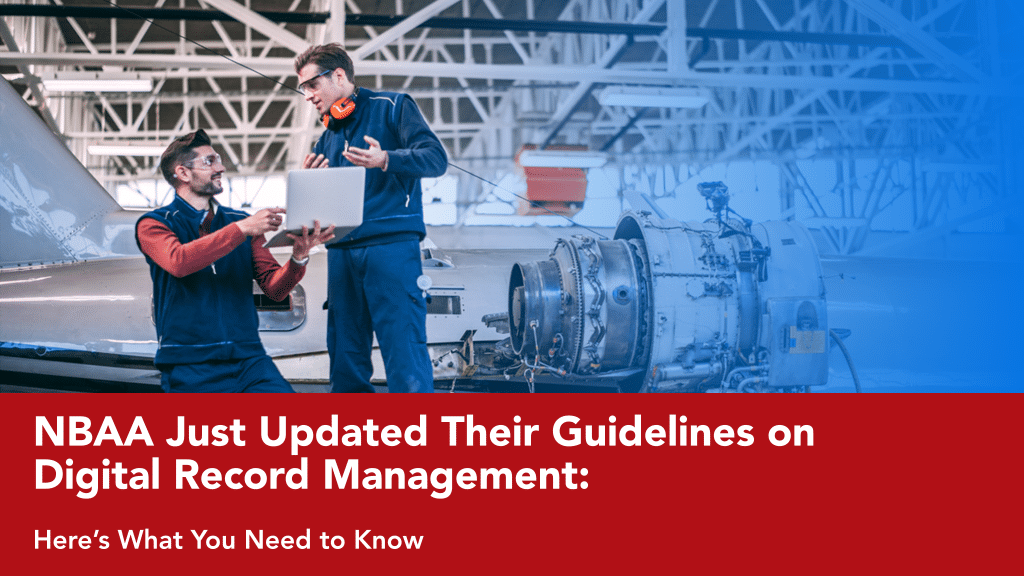As the world of business aviation continues to change, leveraging digital technology is becoming more and more important.
And, let’s face it — evolution in our world is nothing new. Think about it. The analog multimeter was replaced by the digital version (and quickly became the standard). Communicating with your team via letters and post-its became cellphone. And even clocking in to start the workday went from paper to a computer.
In-kind, the NBAA’s Management Guide recently underwent an evolution itself — adding new sections to help business aviation teams take the leap toward electronic recordkeeping.
As is the case with other organizations, the NBAA is made up of committees and subcommittees with volunteer industry experts (full disclosure here: I’m lucky enough to be one of them). Even cooler? Cumulatively, these subcommittees have hundreds of years of collective industry experience.
The subcommittee responsible for the digitization updates, the Regulatory and Operational Control Subcommittee, definitely took their job seriously. We spent countless hours surveying operators, talking, debating, weighing, and editing to land on some solid recommendations moving forward.
The end product? The newly revised NBAA Management Guide now contains information about how to utilize electronic recordkeeping in your operation. This update is timely, and will definitely help direct operators to transition from paper-based aircraft maintenance records to modern, digitized records (aka the future).
Details include the many benefits and advantages electronic recordkeeping provides for all types of operators, and more, how operators can obtain FAA approval if required. So, what are the changes to the NBAA Management Guide that you need to look out for? What’s next?
Section 3.8.4.1
This section highlights new information and details of the regulatory guidance, including the benefits, FAA approval for operators, methods to digitize your records, and implementation processes to guide you forward.
Why should you care?
The trend to digitization is accelerating in aviation. While change is a bit slower than in other industries, there is steady progress. There are many benefits to utilizing electronic recordkeeping for your aircraft maintenance records including security, searchability, and shareability. All of this reduces the risk of loss or damage to these vital records and ensures the value of your managed asset. Plus, the compliance status alone is of the utmost importance.
Additionally, if you’re using a vendor that provides aviation-specific software, integrations with other software that you use can make the process simpler. Searching for a word or a part number manually can be a painstaking exercise, and software offers quick searching of all records to locate that “needle in the haystack” record.
What actions should you take?
• Obtain buy-in from all departments and groups involved within your operation to go digital.
• Make a plan. Determine if you will take this on internally or hire a vendor.
• When starting, have routine check-ins with all individuals and groups involved (and vendors if used) to keep on track.
Best practices
The new “Best Practices” section of the guidelines summarizes the entire project to ensure repeated success when adding additional aircraft or team members. This sets the standard within your organization and ensures continuity and peace of mind.
Why should you care?
Having a documented process to follow, whether included in your manual system or as a stand-alone SOP, will ensure continued success as your fleet and team grows and/or changes.
What actions should you take?
• Document your processes and procedures so that they’re easily repeatable.
• Perform a retrospective after completing your digitization efforts.
• Learn what worked (and change what didn’t).
Expanded Section 3.8.1.8
This revised section gives added information around when and how to use electronic signatures. This also details the benefits, regulatory guidance, info on FAA approval for operators, and methods to implement an electronic signature process.
Why should you care?
As with electronic recordkeeping, using electronic signatures for both approval for return to service records (logbook entries) and additional workflow documentation (work orders, task cards, etc.) can greatly increase efficiencies within your maintenance department.
What actions should you take?
• Much like electronic recordkeeping, obtain buy-in from all departments and groups involved within your operation.
• Check with your current, and possibly other, maintenance tracking programs for their availability and useability of an electronic signature function.
• Document your processes and procedures to ensure future success.
The NBAA is recognizing the technological shift in our industry. And with the updated guidelines and processes, it’s never been easier to go digital. Even better? When it comes to taking the leap to electronic recordkeeping, there are definitely options out there that offer minimal disruptions to you and your business while things are moving full speed ahead.
So, if you were ever thinking of going digital (and hint, hint: you should be!), there is no time like the present to make it happen.
Roy Gioconda is currently the vice president, solutions at Bluetail, where he helps to shape the current and future state of Bluetail’s SaaS platform. With more than 40 years of experience in the aviation industry, he has done everything from directing quality assurance and leading customer success, to roles as a director of maintenance. Gioconda is an Embry-Riddle Aeronautical University graduate, and holds an FAA Airframe & Powerplant certificate.

